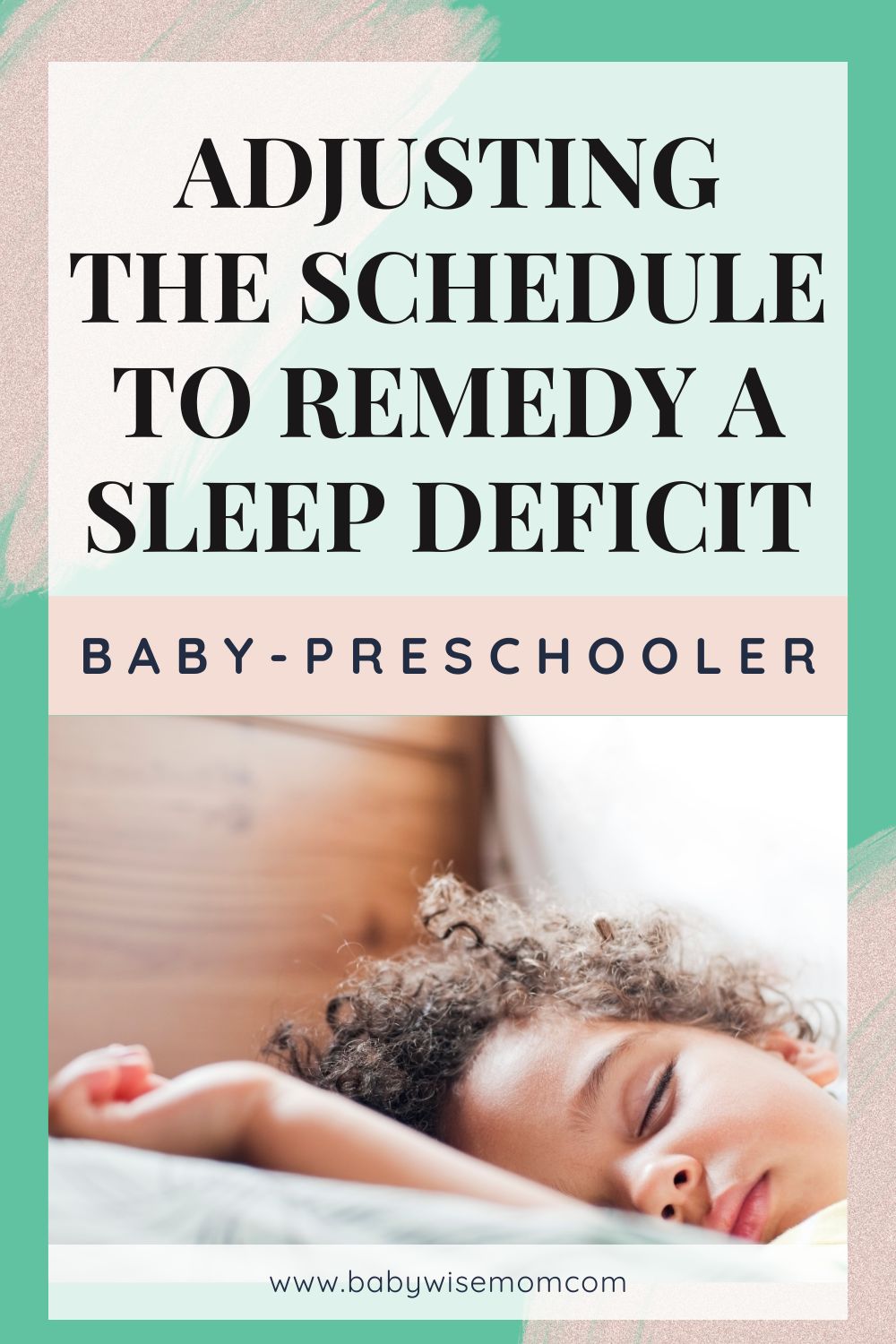A sleep deficit is when your child has not been getting enough sleep for an extended period of time. When this happens, you will need to adjust the schedule so your kiddo will no longer be overly tired. Read all about that, how to adjust the schedule, and important tips for having a solid daily routine.

Contrary to popular belief, the more tired your kiddo is, the harder it will be for them to sleep well. A sleep deficit, or sleep debt, is just like a financial debt that you own interest on. The debt continues to grow until you pay it down.
If your child has a sleep deficit, you will need to work on adjusting that schedule to make up for the lack of sleep.
Post Contents
- Sleep Deficit Overview
- How to Adjust the Schedule to Recover from a Sleep Deficit
- Lengthen Naps
- Shorten Wake Windows
- Move Bedtime Earlier
- Start Your Day Later
- Add a Nap
- Lengthen the One Nap
- Increase Mental and Physical Stimulation
- Basic Schedule Pattern
- Baby’s Daily Schedule
- Toddler’s and Preschooler’s Daily Schedule
- Wake Windows
- Stimulation Levels
- Sleep Training
- Conclusion
- Related Posts
Sleep Deficit Overview
A sleep deficit is when your baby or child has not been getting enough sleep. Over time, that lack of sleep adds up and causes sleep problems for your child. That leads to trouble falling asleep and trouble staying asleep.
A sleep deficit takes time to build up. So if, for example, you dropped a nap two weeks ago, it might start off fine, but two weeks later, your little one is just exhausted and needs more sleep.
How to Adjust the Schedule to Recover from a Sleep Deficit
In order to recover from a sleep deficit, you need to add more sleep in a 24 hour period. There are many ways you can do this. Consider the following options and choose the one that works best for your child and your schedule constraints.
Lengthen Naps
An option that should work for any child of any age is to lengthen a nap or multiple naps. Let your kiddo sleep longer at nap time to make up for the sleep debt your child has incurred.
Shorten Wake Windows
You can also shorten wake windows (or time awake between naps). This might naturally happen if you lengthen naps. But sometimes shortening a wake window will enable baby to have an easier time sleeping. This is discussed in more detail below.
>>>Read: How to Tell if Baby is Overtired vs. Undertired
Move Bedtime Earlier
You might consider moving bedtime 30-60 minutes earlier as your child “catches up” on sleep.
Start Your Day Later
You can also lengthen night sleep by starting your day later than you have been. The idea here is that you are adding sleep to your night, so if you start the day earlier, you want to keep bedtime at the same time it already is.
Add a Nap
One thing to consider is to add a nap to your little one’s day. This is a good option for a toddler or an older baby who has dropped a nap already. This is a good consideration if you have dropped a nap in the last few weeks.
Lengthen the One Nap
If your child is on one nap a day, start that one nap earlier and/or let your child sleep later for that one nap. You will want to keep morning wake up time the same and keep bedtime the same.
Increase Mental and Physical Stimulation
Sometimes older babies, toddlers, and preschoolers struggle to sleep because they aren’t enough mental and physical stimulation. Read books, let your child play on the floor, go for walks, do simple learning time activities, get your kiddo moving, etc. There is more on this concept below.
Also, if you have a younger baby, you might need to lessen the physical or mental stimulation.
Basic Schedule Pattern
Your daily routine should have a set pattern to it. The exact pattern you follow will depend on your child’s age.
Baby’s Daily Schedule
A baby will follow an eat/wake/sleep cycle for much of the first year. That will mean your baby gets up, eats, plays, and then sleeps. Then repeat.
As naps are dropped, that exact pattern will change. For example, when your baby is at 2 naps a day, there will be a point at the end of the day you get up from the second nap, eat, play, then eat, and bedtime.
>>>Read: Why an Eat/Wake/Sleep Cycle Works to Get Baby Sleeping
Toddler’s and Preschooler’s Daily Schedule
A toddler will start off with the two naps. So wake up in the morning, eat, play, nap. Eat, play, nap. Eat, play, eat, bedtime.
At some point, you will move to one nap a day. At that point, you will wak up for the day, eat, play, eat lunch, maybe play a bit, nap, snack, play, dinner, play, bedtime.
As your child gets older and becomes a preschooler, you will replace the nap with a rest time instead of a nap.
Wake Windows
It is very important that you get the time between naps right. You do not want your baby up too long nor do you want baby up too short. If you get wake windows, or wake time length, down correctly, your child will fall asleep and stay asleep. If you get it wrong, sleep will suffer and sleep deficit will accrue.
>>>Read: Optimal Waketime Lengths
Stimulation Levels
Another very important element for you to pay attention to is your baby’s stimulation levels. You do not want to overstimulate your kiddo and you do not want to understimulate your little one.
Stimulation is anything that affects the senses and physical activity. Stimulation is often noise and sight. It is also often physical movement. It can also be smells, touch, and taste.
The younger your baby, the less stimulation they can handle. Everything your baby encounters is something new for your baby to process and learn about. That is a lot of work for the brain. The brain processes information while it sleeps.
As your baby gets older, you can allow more stimulation to happen during playtime. Once your baby hits around 9-10 months old, you might need to start to be intentional about adding stimulation–especially physical movement.
>>>Read: Importance of Exercise and Stimulation for Sleep
Sleep Training
If your child cannot fall asleep independently, it will be very hard for your child to avoid or recover from a sleep deficit. If your child cannot fall asleep without help, see Sleep Training Methods: 7 different ways to train baby to find a sleep training method you are willing to use.
Conclusion
If your kiddo is struggling with sleep and has a sleep deficit, follow these tips to help your child get back to a point of getting enough sleep and being well rested. Once your child is no longer in a sleep debt, you can start to slowly adjust the schedule to drop naps, lengthen wake windows, move bedtime back, etc. assuming your child can handle those things at this point in time. If not, just wait for them to be able to make those changes. The day will come.
Related Posts
- How to Fix Your Child’s Sleep Deficit
- Baby Takes Short Naps: First 5 Things to Check
- Sleep Regressions: Causes, Ages, and What to Do
- Baby Waking Shortly After Bedtime: What To Do
- The Complete Guide to Troubleshooting Short Baby Naps
- How To Solve Your Baby’s Nighttime Sleep Issues

